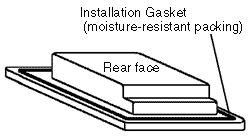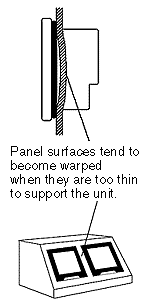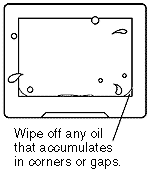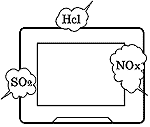| When an operator interface is not equipped with a level of protection that meets or exceeds the demands of its operation environment, its full range of features cannot be utilized. More importantly, the failure of an insufficiently protected unit can lead to equipment damage or, in the worst case, operator injury. This section explains the various levels of protection provided by Pro-face operator interfaces, and lists a number of important work-environment cautions. |
|
|
|
| 1. Protection Features |
| Pro-face products are designed with a variety of levels of protection, levels that differ depending on the model. The standard level of front face protection used with most Pro-face products is "IP65f", equivalent to the Japanese JEM1030 (Control Equipment Protection Features) standard. Our testing has shown that a front panel designed to meet the IP65f standard provides the following protection against the ingress of water and oil. |
|
| (1) |
Water Resistance
Operator interface performance was unaffected when the front face was sprayed with water at a rate of 12.5 liters per minute for a minimum of 3 minutes, from a distance of approximately 3 meters (10 feet) using a 6.3 mm diameter nozzle. |
 |
| (2) |
Oil Resistance
Operator interface performance was unaffected after JIS K 2241 (Japanese Industrial Standard) non-water-soluble type 2 No. 5 cutting oil (refer to p.8) was allowed to drip over the unit's front face at a rate of 0.5 liters per hour for 48 hours. |
|
(Note: Unit installation gaskets must be properly attached and replaced periodically.) |
 |
|
| 2. Installation Gasket Precautions |
To ensure your Pro-face operator interface has the designated level of dust, water and oil resistance, check that the pre-installed gasket is securely attached before installing the unit.
Over time gaskets naturally become scratched and dirty and will eventually be unable to provide the specified level of ingress protection.
The degee of a gasket's deterioration will depend on the severity of its usage environment. As a result, be sure to install a new gasket periodically, or when it appears to need changing.
Generally, we suggest replacing gaskets once a year, or as soon as there are obvious signs of scratches and dirt. (Click here for further information.)
When removing a unit that is built into equipment or machinery, be sure to replace the gasket.
Also, be sure to insert the new gasket carefully into its groove in the front panel bezel, and be careful not to stretch or tear it.
When reattaching the unit, be careful not to twist or pull the gasket out of its groove. |
 |
Note: The following conditions may reduce the gasket's protection level.
 |
If the operator interface's installation surface is uneven (i.e. bent or warped). |
 |
 |
If the gasket material is degraded by contact with chemicals or other substances. |
Please understand that Pro-face cannot guarantee that this gasket will provide protection equivalent to the specified standard in every type of working environment. |
|
| 3. Oil Mist Precautions |
 |
In areas where cutting and grinding oils are used, these oils may penetrate inside equipment and machines through rear face openings. As a result, be sure to completely seal your equipment or machine to protect the Pro-face display. |
 |
 |
 |
In work areas where cutting and grinding oils are used, or where very low viscosity oil is used, airborne oil particles will often adhere to the front panel of the operator interface. Often special protective measures need to be taken when using the Pro-face unit in this type of environment. Therefore, prior to installing this unit, be sure to confirm the type of conditions that will be present. |
 |
 |
Be sure to regularly wipe all oil and dirt off the unit's front panel. |
|
|
| 4. Metal Particle Cautions |
 |
Metal cutting or grinding processes produce large amounts of fine metal particles that can penetrate into equipment and machines through rear face openings. As a result, we strongly suggest that you completely seal your equipment or machine to protect the Pro-face unit. |
 |
 |
In areas where metal powder or particles are present in the air for extended periods of time, particles will eventually penetrate inside most equipment and machines, sometimes causing a malfunction. Therefore, avoid using the Pro-face unit in this type of area. |
|
|
| 5. Gas Precautions |
Never use the Pro-face display in areas where corrosive gases are present. These gasses are usually present in plants where corrosive products such as hydrochloric acid (HCl), nitric acid (NOx), sulfuric acid (SO2), sulfur gas, etc. are used.
If corrosive gasses penetrate inside the GP, there is a chance that an electrical or mechanical part may fail.
-
-
|
| Examples |
 |
 |
Damage to hard or floppy disk drives |
 |
 |
Damage to computer chips and printed circuit boards |
|
 |
|
| 6. Compressed Air Cautions |
| Be careful when using compressed air for cleaning, since there is a risk that the force of the air may loosen the panel's front cover sheet, making it difficult to operate the touch panel and ultimately causing the front cover sheet to peel off. To avoid this problem, use only a low level of air pressure. |
|
| 7. Regular Inspection of Your Pro-face Unit |
Regular inspection of your operator interface will allow you to detect signs of potential part and device malfunctions and allow you to take corrective measures before the part or device actually fails.
It goes without saying that no part can be used forever. Even under normal usage conditions, when a part approaches the end of its service life, it will show signs of age and the chances of a malfunction will increase. Replacing parts at regular intervals or when it appears necessary helps you to minimize or eliminate part aging and part failure problems. |
|

